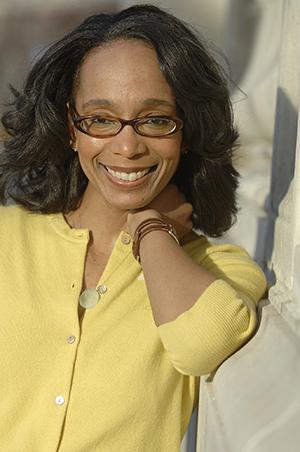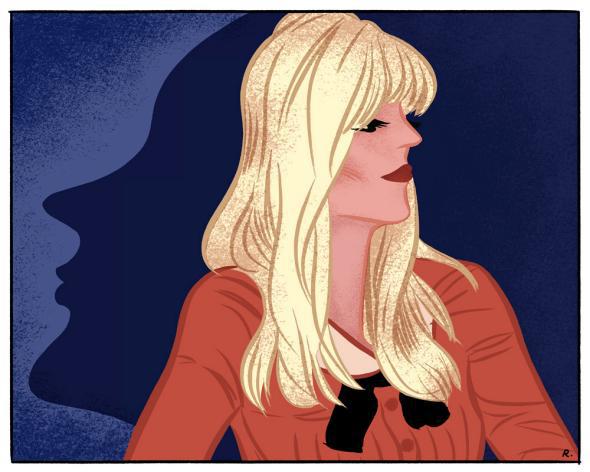Since the Kennedys first descended on Hyannis Port, fresh-faced, long-limbed, sun-kissed models have been used to sell rugby shirts, shorts embroidered with anchors, and plaid everything. But the fashion industry wasn’t always so enamored with looking American, whether narrowly defined as WASP-y or broadly characterized as un-European. The birth of the American fashion model is chronicled in two recent books, Robert Lacey’s Model Woman: Eileen Ford and the Business of Beauty and Robin Givhan’s The Battle of Versailles: The Night American Fashion Stumbled Into the Spotlight and Made History. Model Woman is a biography of Ford, who founded the influential Ford Model Agency (now Ford Models) in 1946; The Battle of Versailles re-creates the landmark fashion show held at the Palace of Versailles in 1973, when a visiting contingent of American designers (and models) stole the show from their more established French counterparts. With their overlapping casts of eccentrics, the books are as glamorous and gossipy as one could wish. But both deliver powerful messages about how we Americans see ourselves, or wish we could see ourselves.
Lacey and Givhan take us back to a time when models were still called mannequins, their agents were viewed as little more than pimps, and modeling was considered “a glamorous job, but not a road to immense wealth,” in Givhan’s words. Beauty itself was a prized asset, however, which demanded to be cultivated. “In today’s judgment, relying on one’s appearance for advancement may be disdained,” Givhan notes. “But throughout the 1940s and ’50s, a woman would be declared foolhardy and unambitious if she failed to exploit her valuable gift of beauty, just as a musical prodigy would be deemed a disappointment if he shunned the concert stage.” Though a woman’s career opportunities may have been limited, she could improve her financial prospects, social standing, and quality of life by attracting a rich husband. Fashion was a means to that end. The French haute couture industry set the standard of female beauty for the Western world: “underfed,” “super-sophisticated,” and “indoorsy,” in the New York Times’ words. Beauty was something foreign, expensive, and, for most Americans, unattainable.
Cute but not beautiful, Eileen Ford could not rely on her appearance for advancement. Although she dabbled in modeling as a teenager, she was realistic about her limited prospects; her biggest takeaway was how badly the American fashion industry treated (and paid) models. Ford saw a business opportunity, and she was instrumental in elevating models from underpaid nobodies to superstars who “don’t wake up for less than $10,000 a day,” as Linda Evangelista (who worked for a rival agency) famously quipped. In the process, Ford redefined beauty as an American trait.
World War II was a turning point for the American fashion industry. With Paris shut down by the Occupation, American designers (and retailers) realized that they could get by just fine without the guiding influence of the French. When the war ended, a wave of fresh talent rejuvenated Seventh Avenue. The 603rd Camouflage Battalion’s Bill Blass turned from painting decoy tanks to designing dresses, and Lacey recounts how U.S. Air Force photographer Bill Helburn parlayed processing pictures of the atom bomb exploding over Hiroshima into a job at Harper’s Bazaar. The art director of Harper’s, Russian expat Alexey Brodovitch, was a fervent convert to “the aesthetic of the New World,” newly burnished by America’s decisive victory. Ford catered to this desire for a uniquely American brand of beauty to complement the country’s postwar self-image, one that could be used to market American fashion to the world.
Though Ford was fond of saying that “every woman can be her own sort of beautiful,” the Ford model tended to conform to a very specific type. From her first appearance on the fashion scene in the late 1940s, she was “tall, slender, blonde, athletic, and straight-backed.” (“Slender people bury the dead” was another of Ford’s favorite maxims.) By the agency’s heyday in the 1980s, this stereotype was deeply ingrained. Photographers boasted that they used only Ford models, and everyone knew what that signified.
Of course, models had always been tall and slim—“walking hangers,” in Givhan’s phrase. But Ford’s models looked healthy rather than wan, relatable rather than worldly; Ford believed that a model had to appeal to women as well as men if she wanted to be commercially successful. On Feb. 10, 1958, the New York Times reported that the “unapproachable and unfathomable” beauty “in all her haughty glory” was falling out of favor in Europe. “Everyone there wants to look American.”
Ford models, including such names as Candice Bergen, Jerry Hall, Christie Brinkley, Kim Basinger, Sharon Stone, and Martha Stewart, were synonymous with this new paradigm of all-American beauty. “Ford models were seen as the aristocrats of their profession,” Lacey writes. “Thighs that stretched for miles; an expectation of blondeness, though not invariably so; and a general impression of extra sparkle, height, and slenderness—stature, in every sense of the word, including mental discipline and punctuality.” Eileen Ford’s “ferocious attention to detail” meant that her models arrived at bookings “with every accessory needed in their model bags, from spare eyelashes to extra hairpieces.” What could be more American than a faultless work ethic?
And Ford models worked, often to surpass their humble upbringings. For though they “all looked brilliantly classy,” as one Vogue editor remembers, Ford plucked many of her models from the wrong side of the tracks. At a time when society debutantes often graced the pages of fashion magazines, these lower-class beauties were novelties, their coarse accents (and vocabularies) contrasting with their aristocratic exteriors. Photographers and fashion editors viewed them as exotic animals, untamed and thrillingly unpredictable. Dovima once used her hotel bidet as a flowerpot.
Soon Ford’s roster began to diversify: Eileen Ford discovered Beverly Johnson, the first black model to appear on cover of American Vogue; Donyale Luna, the first black model to grace the cover of British Vogue; and half-Chinese, half-Portuguese China Machado, who found success despite being rejected by Vogue as “too ‘Chinky’ for us.” Ford’s moves weren’t just political correctness in an era of simmering racial turmoil, but good business sense: Ford made a lot of money exporting these uniquely American looks to Europe, and providing models for ethnic hair and skin product advertisements and magazines like Essence and Ebony.
While Seventh Avenue had only allowed black models to work in the early 1960s if they were light-skinned enough to pass as merely “exotic,” by the end of the decade, unambiguously black models could not only get work, but discovered that they were in demand. In October 1969, Naomi Sims appeared on the cover of Life under the headline “Black Models Take Center Stage.” Mixed-race Alva Chinn suddenly found that “people were telling me that I wasn’t black enough.” Black was officially beautiful.

Photo by Helayne Seidman
Ford regularly sent her Americans to Paris for a season or two, to model the couture collections and acquire the experience (and tear sheets) they needed to compete in New York, where the Paris imprimatur still meant something. But it was not until the night of Nov. 28, 1973, that American models competed with French models in the ultimate walk-off.
When they took the stage of the royal theater at Versailles, the visiting American contingent of 36 models included 10 black women. (One of the few flaws of Givhan’s seductive book is that she focuses on the experiences and impact of these 10 models almost exclusively; as remarkable as they were, surely the other 26 deserve some credit for the Americans’ sensational performance?) The French models who had just left the stage were polished veterans of the well-oiled couture machine; the American models had honed their talents at the disco, the department store, and the Ebony Fashion Fair. The largely French audience was expecting un succès fou, and they got one—but not the one they expected. While the French models posed gracefully in elaborate tableaux that visually overwhelmed their couture gowns as an orchestra played, the Americans stormed the stage in a rainbow of skin tones and uninhibited ready-to-wear looks, stomping and spinning to a pulsing disco beat, and literally danced away with the show.
The five American designers who showed at Versailles that night all had their own ideas of feminine perfection, and fought to include their own house models in the show. Bill Blass “was typically drawn to a Mayflower beauty with an athletic body”—the Ford type. Oscar de la Renta was the closest thing America had to a couturier; his clients were socialites, and his wife had been editor of French Vogue. By contrast, Anne Klein’s sportswear empire catered to the middle class; her customers resembled her clothes, “solidly practical … and, in the vernacular of fashion, boring.”

Photo by Mark Maryanovich
But the other two designers were younger, denizens of the club scene with edgy, cosmopolitan tastes. Roy Halston “liked a lithe physique and a certain sophisticated, jet-setting mystery”; his troupe of “Halstonettes” included “ethnic chameleon” Pat Cleveland and Grace Kelly lookalike Karen Bjornson, his house model. The lone black designer, Stephen Burrows, “preferred his models rail thin. He had a preference for black models, but not to the exclusion of others.” Since the designers shared models at Versailles (because they could not afford to do otherwise), each girl had to be approved by at least three of the five. Coincidentally, the collection Anne Klein planned to show was inspired by Africa; although “she wasn’t known for using black models … she wanted to work with them to give her work cultural legitimacy.”
There was another attraction. While many of the top American models (like Lauren Hutton) were beyond the budget for the show, Tom Fallon, who worked for Blass, recalls of the black models: “You could get them at a bargain price.” All 36 models received a $300 flat fee plus a $25 per diem—“a ridiculously low payday,” Givhan observes. Eileen Ford was aghast when her model Charlene Dash—one of the few black models who had appeared in Vogue—agreed to do to the show, even though she could make $50 per hour in New York. But the chance to fly to Paris for the weekend was an irresistible incentive. Little did Dash know she would return having made history.
“Did the models of Versailles help the fashion industry see black was beautiful?” Givhan asks. “Or did it only see trendy, politically correct mannequins executing a beautiful performance that reflected the particular rhythms of the era?” The evidence strongly suggests the latter. After Versailles, American fashion magazines resisted further diversifying; Vogue, in particular, still faces accusations of whitewashing today. It wasn’t until 1992 that Revlon signed Veronica Webb, making her the first black model to represent a mainstream beauty brand. Black models have cycled in and (mostly) out of fashion ever since. Givhan points out that “the era of the Brazilian bombshell, led by Gisele Bündchen, mostly left out black models.” She credits Versailles with challenging if not changing the dominant standard of beauty, but her argument that “every time the fashion runway makes a place for a plus-size woman, an eccentric tomboy, an awkward aristocrat, or four dozen sorority girls, it is a nod to Versailles” feels like a stretch, giving the event both too much and too little credit.
Fashion has a short memory—it resets itself every six months—and the Versailles show was largely forgotten until the 2012 documentary Versailles ’73: American Runway Revolution revived interest in it. The black models may have been a revelation to the French, but they’d been a presence on Seventh Avenue for a decade. Was America’s newfound self-confidence still so fragile that it required French approval to appreciate what was right under its nose? It would not be the first time; one of the performers in the French portion of the show was American-born Josephine Baker, and several of the American audience members wore French couture.
Though the question of racial equality in the fashion world was not settled that night at Versailles, another one was: “Every subsequent generation of designers has been secure in the knowledge that they did not have to emulate the methods and sensibilities of Paris in order to succeed or be taken seriously,” Givhan writes. “Versailles helped free American designers to think like the entertaining capitalists that they were.” The modern-day $200 billion American fashion industry represents the spoils of the battle of Versailles. Today, “couture has become a charming niche art that is worth admiring but wields little influence,” Givhan, the fashion critic for the Washington Post, concludes. “Contemporary dressing is American-style dressing: full of ease, sportiness, and fun.” It’s a good look.
—
Model Woman: Eileen Ford and the Business of Beauty by Robert Lacey. HarperCollins.
The Battle of Versailles: The Night American Fashion Stumbled into the Spotlight and Made History by Robin Givhan. Flatiron Books.
See all the pieces in this month’s Slate Book Review.
Sign up for the Slate Book Review monthly newsletter.
